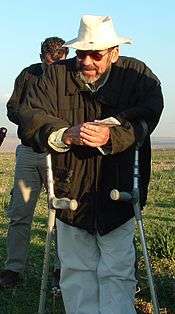Adam Zertal

Adam Zartal, January 2005
Adam Zertal (Hebrew: אדם זרטל; 1936 – October 18, 2015) was an Israeli archaeologist.[1]
Biography
Adam Zertal grew up in Ein Shemer, a kibbutz affiliated with the Hashomer Hatzair movement. Zertal was severely wounded in the Yom Kippur War. He later told a reporter for the Jerusalem Post, “I spent a year at Hadassah Hospital in Jerusalem, and I became interested in archaeology. Although I had argued that the Bible was full of myths, I decided after my recovery to travel the land by foot to look for archeological evidence.”[2]
Archaeology career
Zertal identified several sites he worked on as being connected to sites, events and characters from the early periods of Israelite presence in Cannan/the Land of Israel.
- Joshua's altar (?). A structure on Mount Ebal identified as an early Israelite altar.[3]
- Siser'as town (?). Zertal headed the excavations at El-ahwat, which he has identified as the Biblical Harosheth Haggoyim, a fortress described in the Book of Judges as the fortress or cavalry base of Sisera, commander of the army of King Jabin. (Judges 4)[2][4]
- Foot-shaped enclosures in the Jordan Valley. Zertal described them as ceremonial sites used during Iron Age I and probably later, as well.[5] He explained the term "aliya la-regel" (lit.: "rise to the foot"), commonly translated as "pilgrimage", as derived from these enclosures, and saw the use of the expression in connection with the mandatory pilgrimage Temple in Jerusalem as an adaptation of the term to a new situation.[5] He saw a direct connection between the foot shape of the enclosures and the biblical concept of taking ownership over a territory by walking on it, or in other words setting one's foot on it,[5] as seen for instance in Genesis 13:17 and Deuteronomy 11:24, or of more generally "stepping in someone's shoes" and inheriting their property as in Ruth 4:7-9.[6]
- Underground quarry (Galgala?). In 2009, Zertal headed a team that discovered an ancient underground quarry in the Jordan Valley.[7] He associated the cave with two Byzantine-period place names, Galgala and Dodekaliton (Greek for "Twelve Stones"), marked on the Madaba map next to each other and at a distance from Jericho that matches the cave's distance from the city. He offered the interpretation that the Byzantines had identified the site as Gilgal, where the Children of Israel had set up the twelve stones they had taken from the Jordan River while crossing it (Joshua 4:20).[8]
References
- ↑ http://www.tabletmag.com/scroll/194382/adam-zertal-israeli-archaeologist-who-identified-joshuas-altar-at-mt-ebal-dies-at-79
- 1 2 Siegel-Itzkovich, Judy (July 2, 2010). "Long time archaeological riddle solved, Canaanite general was based in Wadi Ara". Jerusalem Post.
- ↑ Zertal, Adam. "Shechem and Mount 'Ebal in the Bible: Is this indeed Joshua's altar?". University of Haifa.
- ↑ "Archaeological mystery solved". University of Haifa press release. July 1, 2010. Archived from the original on 2010-07-05. Retrieved 2010-07-02.
- 1 2 3 Rachel Feldman [Haifa University official blog): Enormous 'Foot-Shaped' Enclosure Discovered in Jordan Valley Archived 2016-04-19 at the Wayback Machine.
- ↑ John Black (International Christian Embassy Jerusalem), "Footprints of Ancient Israel: Unusual stone circles may mark biblical 'Gilgal'", first published in The Jerusalem Post Christian Edition, January 2013
- ↑ Lefkovits, Etgar (June 21, 2009). "Huge Roman-era cave found by Jericho". Jerusalem Post.
- ↑ Underground Cave Dating From The Year 1 A.D. Exposed In Jordan Valley, Science Daily, (July 7, 2009).
Bibliography
- Zertal, Adam (2004). The Manasseh Hill Country Survey. 1. Boston: BRILL. ISBN 9004137564.
- Zertal, Adam (2007). The Manasseh Hill Country Survey. 2. Boston: BRILL. ISBN 9004163697.
- Zertal, Adam (2016). The Manasseh Hill Country Survey. 3. Boston: BRILL. ISBN 9004312307.
- Zertal, Adam (2017). The Manasseh Hill Country Survey. 4. Boston: BRILL. ISBN 9004346961.
This article is issued from
Wikipedia.
The text is licensed under Creative Commons - Attribution - Sharealike.
Additional terms may apply for the media files.